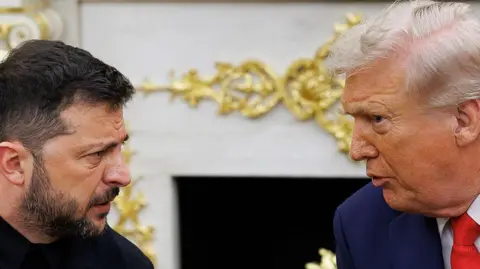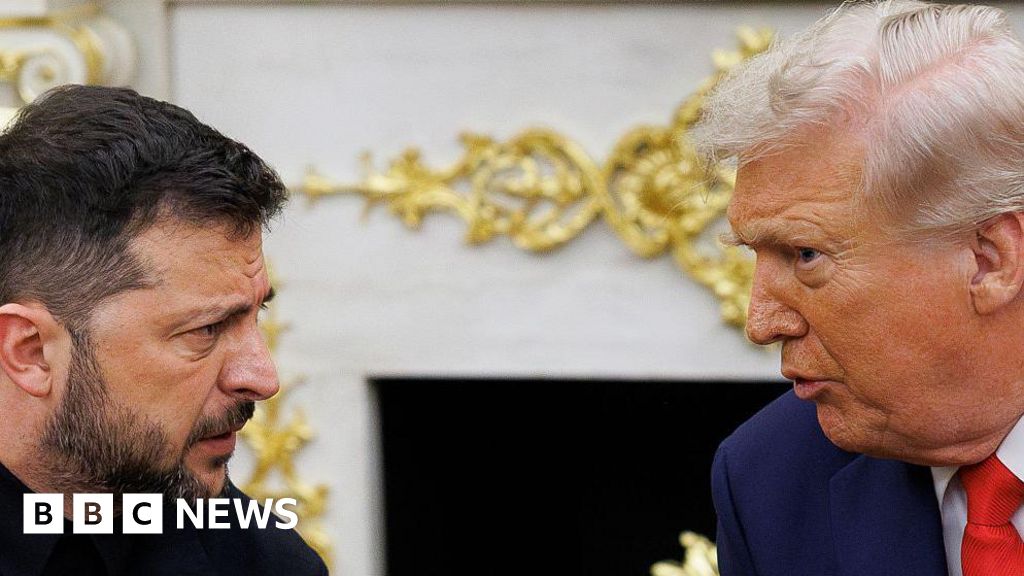 Getty Images
Getty ImagesLast Friday, Donald Trump and Vladimir Putin met in Alaska for a summit that was high on pomp and pageantry and low on diplomatic breakthroughs in the push to end the Russia-Ukraine war.
On Monday, six European leaders rushed to Washington DC to meet with Trump and assess the consequences of that Putin meeting. While the gathering at the White House was historic, it too was heavy on rhetoric and light on tangible progress.
With little to show from two summits, pressure is intensifying on a president who made ending foreign wars a key campaign promise. But there were two potentially significant developments.
In Monday’s White House confab, Trump appeared open to providing US security guarantees for Ukraine if a deal is struck. That is viewed by the Ukrainians, and their European allies, as an essential component in reaching a durable peace.
On Tuesday morning, Trump hedged a bit, saying a US commitment might entail “air support” rather than American soldiers in Ukraine and that Europe would have to shoulder most of the burden.
He also said “arrangements” were being made for a bilateral summit between Putin and Zelensky – although the location and details remain very much up in the air – after which he would directly participate in a three-way meeting with the two men.
European leaders also want a ceasefire in place before any bilateral meeting, something Trump has said is not likely.
Still, any steps however small towards direct, leader-level negotiations between Zelensky and Putin is an accomplishment.
The simple fact that yesterday’s meetings between Trump and Zelensky, and the larger gathering of European leaders, was conducted in a friendly, co-operative fashion is itself notable given Zelensky’s acrimonious White House visit in February and the sometimes contentious relations Trump has had with his European counterparts.
Trump seemed to enjoy being the gracious host both in Alaska and at the White House, and his comments suggest he views ending the war in Ukraine as a key to cementing his legacy.
“If I can get to heaven, this will be one of the reasons,” he said in a Tuesday television interview.
But the path to heaven is narrow, as the saying goes, and there are still numerous obstacles to ending the war in Ukraine, not the least of which is that it is still not clear that Putin wants the war to end when he is making grinding progress on the battlefield.
The Russian leader may feel that his position only grows stronger as time goes by and that the best strategy is to slow negotiations while avoiding new US sanctions that could further damage its economy.
Trump has put those sanctions, which appeared likely as recently as two weeks ago, on indefinite hold, and he appears to legitimately believe that Putin wants to make a deal.
In private comments to French President Emmanuel Macron that were picked up by a live microphone, Trump said as much.
“I think he wants to make a deal for me, you understand that?” Trump said. “As crazy as it sounds.”
It may sound crazy given that Putin has continued his relentless attacks on Ukraine for nearly four years. It may also sound naïve. But the American president is putting a considerable amount of faith in Putin’s supposed good intentions.
Even if Putin proves to be a reliable negotiating partner – a big if – Trump himself can be a mercurial ally. While the meetings at the White House went smoothly, he has made hairpin turns in American foreign policy before and he could do so again. Just in the last eight months, his views on Zelensky have careened between sharply critical to supportive.
A peace that depends on American assurances may not be a firm foundation on which to build. The sometimes unseemly efforts of European leaders to lavish Trump with praise on Monday hinted at their concerns about his sometimes tempestuous nature.
“I think in the past two weeks we’ve probably had more progress in ending this war than we have in the past three and a half years,” Finnish President Alexander Stubb said.
The Europeans’ hastily arranged trip to Washington DC was designed to sandwich Putin to limit his ability to influence Trump’s thinking.
Besides the key players, there is another voice factoring into Trump’s decision making process – his political base that takes his “America first”, non-interventionist rhetoric to heart.
Any security assurances, any commitment of military resources or any new foreign obligations Trump might consider taking on to reach a peace deal may be viewed sceptically by his supporters.
They were uneasy during the US strikes on Iran in June, and that was only one night of action. More permanent American obligations to Ukraine at a time when a large segment of the nation would prefer focusing inward could put Trump in a difficult position – one that he might prefer to avoid entirely.
Whatever progress has been made, there is still one fundamental reality that undergirds American involvement in the peace process in the days ahead. Trump may want to be viewed by the world – and history – as a peacemaker. But when compared to Europe, Russia or certainly Ukraine, he has the least at stake during these negotiations.
In the end, Trump could just leave the table. The ability to walk away is also a kind of power.

Follow the twists and turns of Trump’s second term with North America correspondent Anthony Zurcher’s weekly US Politics Unspun newsletter. Readers in the UK can sign up here. Those outside the UK can sign up here.


Leave a Reply